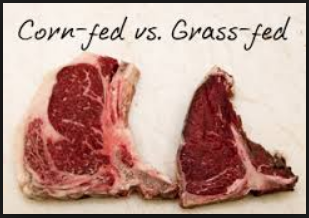 Pasture-based farmers who direct-market their meats are forever answering the same questions from new customers: “What, exactly, are the differences between conventional meats and grass-fed?” Most of us have a bevy of replies on the tips of our tongues: We launch into lectures about the environmental devastation caused by the factory farming industry, we give in-depth explanations about carbon sequestration and how good grazing reduces global warming. We define CLAs and Omega 3s and quote nutritional studies verbatim. We expound on peak oil and demonstrate grazier’s reduced reliance on fossil fuels. We preach about the value of local economies and our role in rebuilding sustainable communities. We bear the simple (albeit noble) title “farmer,” but to do our jobs well, we’ve evolved into chemists, biologists, sociologists, nutritionists, environmentalists, animal rights activists and preachers. Whatever our explanations of the differences may be, the next question we almost always hear following our diatribes is, “But it’s tougher, right?” No.
Pasture-based farmers who direct-market their meats are forever answering the same questions from new customers: “What, exactly, are the differences between conventional meats and grass-fed?” Most of us have a bevy of replies on the tips of our tongues: We launch into lectures about the environmental devastation caused by the factory farming industry, we give in-depth explanations about carbon sequestration and how good grazing reduces global warming. We define CLAs and Omega 3s and quote nutritional studies verbatim. We expound on peak oil and demonstrate grazier’s reduced reliance on fossil fuels. We preach about the value of local economies and our role in rebuilding sustainable communities. We bear the simple (albeit noble) title “farmer,” but to do our jobs well, we’ve evolved into chemists, biologists, sociologists, nutritionists, environmentalists, animal rights activists and preachers. Whatever our explanations of the differences may be, the next question we almost always hear following our diatribes is, “But it’s tougher, right?” No.
More than ever before, folks are willing to try bringing grass-fed meats home for their families. Yet still, the myth prevails, even among grass-fed advocates, that the eating just won’t be the same as the good ol’ grain-fed days.
It’ll be better. In my experience, unless there has been a serious management problem on the farm, grass-fed meat is not tougher than grain-fed. In fact, when I wrote The Grassfed Gourmet, I teamed up with Cornell Meat Scientist Dr. Denny Shaw, and we spent a day cooking up a storm, then running Warner-Bratzler shear tests comparing local grass-fed beef with grain-fed “Certified Angus” beef from the grocery store. In nearly every test we performed, the grass-fed meat received the better tenderness score. While this was only preliminary research (I lack the finances to conduct a full-blown study), I have not yet seen any other studies confirming the “grassfed is tough” myth (if any of you readers know of any, please forward them along).
 In the last few years, I’ve done numerous Farmer and The Grill workshops, where I show up at demonstration sites, receive several varieties of meats from local farms, and face the challenge of preparing whatever I am handed for all the workshop participants to sample. I use only salt, pepper, garlic, and a little kettle grill. I use no fancy tenderizing methodologies, no space-age culinary equipment. We’ve never had a piece of tough grass-fed meat yet. Then why do so many folks report having eaten tough meat? The secret lies in understanding one simple difference between grass and grain-fed meats that many of us, in all our myriad lectures on grass-fed/grain-fed differences, forget to explain to our customers.
In the last few years, I’ve done numerous Farmer and The Grill workshops, where I show up at demonstration sites, receive several varieties of meats from local farms, and face the challenge of preparing whatever I am handed for all the workshop participants to sample. I use only salt, pepper, garlic, and a little kettle grill. I use no fancy tenderizing methodologies, no space-age culinary equipment. We’ve never had a piece of tough grass-fed meat yet. Then why do so many folks report having eaten tough meat? The secret lies in understanding one simple difference between grass and grain-fed meats that many of us, in all our myriad lectures on grass-fed/grain-fed differences, forget to explain to our customers.
Grass-fed meat is variable. We have grown accustomed to an industrialized food system that offers us flavorless, ecologically devastating, potentially toxic, inhumane, nutritionally deficient meat. But it is consistent. And for nearly 50 years, the industrialized food system has been supported by a culinary industry that has educated us on how to make the most of this consistent meat (consistently inferior!).
Grass-fed meats are a product of their ecosystem. And every farm’s ecosystem will be different. Genetics will vary. Pastures will vary. Weather patterns will vary. Individual animals will vary. Farming practices will vary. Butchering practices will vary. All of this is evidence of a healthy, diversified, localized, sustainable food system. The result will be variable meat. A grass-fed rib steak for sale at the farmers’ market may be 1.2 pounds. Another one might be 0.72 pounds. It may grade prime (lots of marbling), choice (a good amount of marbling), or select (lean). Provided the animals weren’t mishandled or improperly grazed, with simple, attentive cooking practices, all grass-fed meats can achieve the desired combination of tenderness, juiciness and flavor.

The key lies in working with the variability. For starters, lower the temperatures at which you cook the meats. If you are grilling, once you’ve seared the meat, finish cooking over indirect heat. If you are oven roasting, lower the temperature. When heat is applied quickly, muscle fibers in the meat contract quickly. When meat is not heavily marbled, there is little fat for insulation to slow the muscle contraction, and your dinner will be chewy. Also, since the fibers are not contracting quickly, less of the juice is lost, resulting in a more moist piece of meat. Thus, lowering the cooking temperature is your insurance policy to protect tenderness and juiciness. Next, use a meat thermometer to gauge doneness. Over-cooking the meat will contribute to dryness. Also, in most cases, I advise that reliably-sourced grass-fed meats be removed from the oven or grill with lower internal temperatures than those recommended by the USDA. This helps to preserve more juice, reduces the sacrifice of those nutritious (CLA and Omega-3-rich) fats to the flames, and enhances the overall nutritional value of the meat. For a quick resource on this, check out my “Don’t Over-Do It” refrigerator magnets here – they list the ideal internal temperatures for grass-fed and grain-fed meats. Also, look carefully at the meat before you cook it. If it is a steak, is it the same thickness that you are used to, or that is called for in the recipe? Is it well-marbled? Lean? If it is thinner, cook it for less time. If it is thicker, be prepared to go a little longer. If it is lean, be extra cautious with the flames or oven temperature. Evaluate your roasts the same way. Bigger pieces of meat will cook longer than smaller pieces.
Remember: Recipes are guidelines for preparing foods. They are not legal documents. Just as we farmers have learned to create food in harmony with our ever-changing ecosystems, where the production of good food is the result of daily attention to the environment and the animals, so too do cooks need to pay attention to our food in the kitchen. We do not need to be gourmet chefs. We simply need to be attentive.
 Finally, start taking more time to enjoy your food. Grass-fed meats take longer to raise up on the farm. Take longer to enjoy them at your table. They have magnificent flavor, and each piece of meat will taste different from animal to animal, farm to farm, region to region. When we eat with attention and celebration, these flavors really shine through. The majority of Americans spend less than 31 minutes around the family dinner table. This allows for hardly any time to converse, and it is a woefully short period in which to fully taste good food that was artfully grown and lovingly prepared. So sit longer, taste more, and enjoy the great food.
Finally, start taking more time to enjoy your food. Grass-fed meats take longer to raise up on the farm. Take longer to enjoy them at your table. They have magnificent flavor, and each piece of meat will taste different from animal to animal, farm to farm, region to region. When we eat with attention and celebration, these flavors really shine through. The majority of Americans spend less than 31 minutes around the family dinner table. This allows for hardly any time to converse, and it is a woefully short period in which to fully taste good food that was artfully grown and lovingly prepared. So sit longer, taste more, and enjoy the great food.





Hi Shannon,
I believe reports in the literature are inconsistent regarding tenderness of grass vs grain finished beef. Variability is likely traced to a number of factors mainly fat cover, muscle glycogen, and age of the animal. With limited fat cover, if post mortem chilling is rapid, you can get cold shortening, which is a pronounced rigor contraction due to an imbalance between intra myocyte (muscle cell) calcium release and uptake, where lower calcium pump efficiency results in greater intracellular calcium levels which triggers contraction. If this rigor does not resolve during aging, the meat can be tougher. Grass finishing can also at times lead to lower muscle glycogen levels, related to differences in rumen volatile fatty acid profiles. When more forage is in the diet, their can be less propionic acid produced in the rumen, which is the precursor for gluose and ultimately glycogen synthesis in the muscle (glucose is not stored in the muscle itself, but is used to make glycogen, which is a polysaccharide). On a grain based diet, you can also get more bypass of starch from the rumen, which can be digested to yield glucose for absorption in the intestine. Muscle with less glycogen does not undergo as extensive anaerobic metabolism, and less lactic acid is produced from glucose (arising from glycogen), and muscle pH does not drop as much as normal. The meat can be darker as a result, and I believe sometimes resolution of rigor (i.e. Tenderization over time related to aging) can be impaired. Regarding the age of the animal, I believe connective tissue in animals older than about 16 months of age starts to toughentoug related to collagen cross linkage. The collagen can, however, be solublized with cooking at a lower temperature for a longer period. In your article you mentioned something about contraction during cooking and moisture loss. I don’t think this is actual muscle contraction, but relates more to connective tissue shrinkage. I hope this info helps sheds some light on why grass fed beef can at times be tougher than grain fed.
Comments are closed.